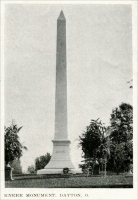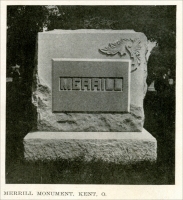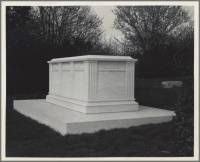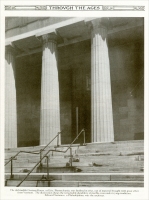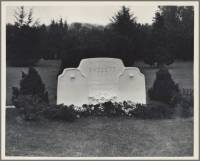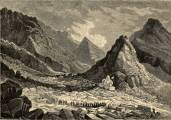
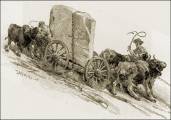

Structures and Monuments
in Which
Vermont Stone was Used
Finished Products from Vermont Stone
- Finished Products from Vermont Stone in Ohio
- Belleville, Ohio – the Bert Hess Family Memorial Monument (Advertisement from The Monument and Cemetery Review, March, 1949, pp. 3)
A Barre Guild Contest Winner
The Selby Design, an entry in a 1942 competition among members of the Barre Chapter of the Society of Memorial Draftsmen & Designers, sponsored by the Barre Granite Association, won one of the fifteen merited awards….”
The Hess monument was manufactured of Pirie’s Select Barre Granite by Anderson-Friberg Co., Inc., of Barre for their popular Ohio Representative, Bert Hess, who chose the Selby design for his own family memorial in Belleville, Ohio. This monument was featured in the Barre Guild Exhibit at the 1946 National Convention in Cleveland.
J. K. Pirie Estate – Barre, VT.
Quarriers of Pirie’s Select Barre GraniteThe Bert Hess family memorial monument in Belleville, Ohio (J. K. Pirie Estate advertisement in The Monument and Cemetery Review, March 1949, pp. 3) 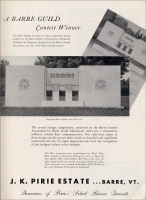
- Canton, Ohio – the McKinley Mausoleum - the Two Monolithic
Sarcophagi (from The Commercial Granites of New England,
Bulletin 738, 1923.)
Granite quarried from the Mower Quarry located at Windsor, Vermont, was used in the construction of the two monolithic sarcophagi in the McKinley Mausoleum.
- Cincinnati, Ohio – the Central Trust Bank Tower in
Downtown Cincinnati (completed in 1913) (The brochure presents a photograph
of the Central Trust Bank Tower.) (From Guide to the Building
Stones of Downtown Cincinnati: A walking tour in celebration
of Earth Science Week 2000, by J. T. Hannibal and R. A.
Davis, Ohio Division of Geological Survey Guidebook No. 7, 44
p., 1992, [Reprinted, 1996.] Building Stones in the Vicinity
of Fountain Square, Cincinnati, Ohio, a brochure based on
the guidebook, was published in 2000 and is available on line.)
White marble from Vermont was used as a facing on the lower part of the building. Terra cotta was used to face the upper floors. A gray igneous rock was used on the base of the building. Pink-and-black banded Morton Gneiss was used for the steps leading down under the east side of the building. Morton Gneiss is quarried in southwestern Minnesota in Morton, and a couple of the commercial names it is know as are Rainbow granite and Minnesota granite. The author notes that the Morton Gneiss is widely used as monuments and cemetery headstones. Roman travertine, quarried in Tivoli, Italy, was used in the interior of the building.
- Cincinnati, Ohio – the Fleischmann Mausoleum (from The
Commercial Granites of New England, Bulletin 738, 1923.)
Granite quarried from the Smith Upper Quarry located in Barre, Washington County, Vermont, was used in the construction of the Fleischmann Mauscoleum in Cincinnati.
- Cincinnati, Ohio – the Ingalls Building in Downtown
Cincinnati (completed in 1903) (The brochure presents a
photograph of the Ingalls Building.) (From Guide to the Building
Stones of Downtown Cincinnati: A walking tour in celebration
of Earth Science Week 2000, by J. T. Hannibal and R. A.
Davis, Ohio Division of Geological Survey Guidebook No. 7, 44
p., 1992, [Reprinted, 1996.] Building Stones in the Vicinity
of Fountain Square, Cincinnati, Ohio, a brochure based on
the guidebook, was published in 2000 and is available on line.)
White Vermont marble was used on the exterior of the first three stories of the building. The stone has grayish-green streaks. Travertine, a "cream-colored marble that has golden to black veining," was used on the walls and a ceiling at the Fourth Street entranceway.
- Cincinnati, Ohio – McMicken Hall, Cincinnati University (The
link from which the following information was obtained is no
longer available.)
<http://jacross.homestead.com/UCpage3.html>Multi-colored slate from Vermont was used to construct the roof on McMicken Hall and TUC. The multi-colored slate contains red, green, and gray colors.
- Cincinnati, Ohio – Spring Grove Cemetery – the George W. Hill Memorial (from “Types of the Year’s Best Cemetery Monuments: Many Distinctive Types: Development of Tablet and Cross Forms” (pdf), from The Monumental News, Vol. XXXIII, No. 1, January 1921, pp. 21.)
“Two of the finest of our modern upright tablet forms are seen in the ‘George W. Hill’ and the ‘Scott’ memorials, both the work of McDonnell & Sons, of Buffalo, N.Y., and designed by their chief designer, John Francis Stanley, whose mastery of this type of memorial architecture is well known to readers of Monumental News. The rare grace of line and purity of decoration in these memorials stamp them as classics in their particular class. The Hill is Egyptian in style and the artistry with which the typical Egyptian ornaments have been adapted to the lines of the work renders its decorative character as pleasing as its just proportions. This work stands in the Spring Grove Cemetery, Cincinnati, and measures 9-0x6-0 at the base and 15-1 high…Both of these works are in Barre granite and were executed in the Barre plant of McDonnell & Sons.”
- Cleveland, Ohio – the City Hall (from The Commercial
Granites of New England, Bulletin 738, 1923.)
Granite quarried from the Four Robeson Mountain quarries located in Woodbury, Washington County, Vermont, was used in the construction of the Cleveland City Hall.
- The Cleveland, Ohio, City Hall Building – The
following information on the construction of the building was
taken from a colorized postcard, #H04125, published by Geo.
R. Klein News Co. of Cleveland, Ohio, Tichnor Quality Views.
"The following information about the stones used in the construction appears on the back of the postcard: "Lakeside Ave. at East 6th St., overlooking Lake Erie. This magnificent building of modified Roman architecture is of steel construction and reinforced concrete with walls of Vermont gray granite. The great entrance hall is walled with Botticini marble, imported from Italy. Formally opened in 1916. Of special interest is the City Manager's suite, the Council Chamber and the large painting Spirit of '76."
- The Cleveland, Ohio, City Hall Building – The
following information on the construction of the building was
taken from a colorized postcard, #H04125, published by Geo.
R. Klein News Co. of Cleveland, Ohio, Tichnor Quality Views.
- Cleveland, Ohio – the Wade Memorial Chapel (from The
Commercial Granites of New England, Bulletin 738, 1923.)
Granite quarried from the Barclay Quarry located at Barre, Washington County, Vermont, was used in the construction of the Wade Memorial Chapel in Cleveland.
- Cleveland, Ohio – the Wade Memorial Chapel (history) Presented on the Guide To Stones Used for Houses of Worship in Northeastern Ohio web
-
Dayton, Ohio – Woodland Cemetery – the Knerr Family Monument (from The Monumental News, Vol. XVIII, No. 3, March 1906, pp. 224)
“Noteworthy among the recent additions to beautiful Woodland Cemetery at Dayton is the Knerr family monument, illustrated on this page. It is made of light Barre granite, twelve cut throughout, and stands 35 feet high, rising from a base 8-6 x 8-6 x 1-4. The carved frieze under the projecting cap above the die was carried out with good effect. Thos. Staniland & Sons, of Dayton, were the designers and contractors, and the work was executed for them by Barclay Bros., of Barre, Vt.”
- Fostoria, Ohio – Garden of Memory – the Pillars Memorial (from Vermont Marble Company Dealer’s Sales Portfolio: Information on Designs and Other Illustrations, October 1940)
Light gray Barre Granite, quarried southeast of Barre, Vermont, was used for the columns and upper portion of the chapel. Gray Canyon Sandstone, Berea Sandstone, quarried in the area of South Amherst, Ohio, was also set in courses.
-
Kent, Ohio – the Merrill Monument (from The Monumental News, Vol. XVIII, No. 2, February 1906, pp. 158)
“The Merrill monument illustrated on this page is an example of the recent work of Marshall W. Keith, of Kent. It is of dark Barre granite, 6 ½ ft. high, on a base 6 x 2 ½ ft. The photograph was taken by Mr. Keith, who also sends us another photograph of a piece of work of his, and an interesting picture of the ‘Standing Rock’ in the Cuyahoga river, which bounds the local cemetery on one side and gives it its name.”
- Mansfield, Ohio – the Frank Black Sarcophagus (from Vermont Marble Company Dealer’s Sales Portfolio: Information on Designs and Other Illustrations (pdf), October 1940)
- Springfield, Ohio – the General Thomas Memorial - the
Shaft (from The Commercial Granites
of New England, Bulletin 738, 1923.)
Granite quarried from the Barclay Quarry located at Barre, Washington County, Vermont, was used in the construction of the General Thomas memorial shaft in Springfield, Ohio.
- St. Clairsville, Ohio – the Sutton Monument (from The Monumental News, Vol. XVIII, No. 4, April 1909, pp. 317)
- Toledo, Ohio – the Fort Meigs Monument (from The
Commercial Granites of New England, Bulletin 738, 1923.)
Granite quarried from the fletcher Quarry located at Woodbury, Washington County, Vermont, was used in the construction of the Fort Meigs Monument, which is 100 feet high.
- Youngstown, Ohio – the Graham Mausoleum. (from Keeping
Up with Marble, by The Vermont Marble Co., ca. 1913, pg.
37.)
Marble for this monument was purchased from the Vermont Marble Company of Proctor, Vermont. "The Graham Mausoleum, a medium-priced structure formed out of Sutherland Falls marble and erected by H. R. Lewis, Youngstown, Ohio."
“‘Sutton’ monument furnished by Cook & Watkins out of Light Barre Granite for Longley & Co., of St. Clarksville, Ohio.” 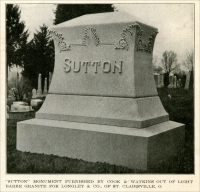
- Belleville, Ohio – the Bert Hess Family Memorial Monument (Advertisement from The Monument and Cemetery Review, March, 1949, pp. 3)
- The Finished Products from Vermont Stone in Oklahoma
- Oklahoma
City, Oklahoma – the State Capitol (photograph
and history)
The exterior of the Oklahoma Capitol is Indiana limestone and the base is Oklahoma pink and black granite. Floors are Alabama marble and the stairs and wall bases are Vermont marble.
- Oklahoma City, Oklahoma - the
Oklahoma Capitol Building (photographs and
history)
The following information is presented on the Seminole Nation, Indian Territory and History & Genealogy web site.) The following stones were used in the construction of the Capitol building: Indiana limestone was used on the exterior of the building. Pink granite from Troy, a southern Oklahoma town, was used for the base of the building on the exterior. Alabama marble was used for the floors throughout the capital, and the wall bases and stairways are of Vermont marble. The outside steps and tables along the Grand Staircase are created from black granite from Cold Springs, Oklahoma.
- Oklahoma City, Oklahoma - the
Oklahoma Capitol Building (photographs and
history)
- Oklahoma
City, Oklahoma – Temple of the Church of Jesus Christ
of Latter-day Saints (photograph and history)
The exterior of the temple is built of white marble quarried in Vermont.
- Oklahoma
City, Oklahoma – the State Capitol (photograph
and history)
- Finished Products from Vermont Stone in Oregon
- Salem, Oregon – the Oregon State Capitol (The
link from which the following information was obtained is no
longer available.) <http://news.statesmanjournal.com/Legislature/about/history.cfm>
Oregon's fourth (and present) State Capitol was dedicated on October 1, 1938. It is a four-story building of Modern Greek architecture. Danby Vermont marble was used in the construction of the exterior of the building. Polished Rose Travertine from Montana was used to line the rotunda, the halls, and all the lobby areas. Large squares of Phoenix Napoleon marble from Missouri was used for the floor and staircases of the rotunda. Radio Black marble from Vermont was used for the borders.
- Salem, Oregon – the Oregon State Capitol (The
link from which the following information was obtained is no
longer available.) <http://news.statesmanjournal.com/Legislature/about/history.cfm>
- Finished Products from Vermont Stone in Pennsylvania
- Bellefonte, Pennsylvania – the Governor Curtin Monument (from The
Commercial Granites of New England, Bulletin 738, 1923.)
Granite quarried from the Jones Light Quarry located at Barre, Washington County, Vermont, was used in the construction of the Governor Curtin Monument in Bellefonte.
-
Brownsville, Pennsylvania – the James S. McCutcheon Monument (from The Monumental News, Vol. XVIII, No. 2, February 1906, pp. 158, 160)
“Harry S. Wright, of Philadelphia, sales agent of the Excelsior Granite Co., Heath Spring, South Carolina, sends us the photograph of the tall shaft shown in the illustration on this page, which was erected by T. S. Wright’s Sons, of Brownsville, for James S. McCutcheon. The total height of the monument is 85 ft. on a base 24 ft. suare (sic). The die weighs 18 tons, is in one piece, and had to be hauled six miles by thirty-eight horses. The work was erected complete without a mishap in thirty days, and the total cost was $20,000. Mr. McCutcheon left his entire fortune to be expended, and named T. S. Wright’s Sons in his will to do the work, leaving also a sketch of the design he wished executed. Mr. Harry S. Wright closed the contract for this monument about three years ago, and considers it one of the tallest in the country. It is of Barre granite throughout. Mr. McCutcheon was a frugal man and saved during his entire life to gratify his desire to have a more pretentious monument than any of his neighbors. The foundation was constructed during his life time. The total weight of the monument is 500 tons.”
- Brownsville, Pennsylvania – the James S. McCutcheon Monument (from Granite, Marble and Bronze, Vol. XVIII, No. 4, April 1, 1908, pp. 16)
“Destruction of an Expensive Monument,” by H. G. Lawrence
“Lightning has struck and ruined one of the most unique monuments in the United States, a towering shaft of Barre granite, 86 ½ feet high, which stands within 4 miles of the birthplace of James G. Blaine, in the Taylor Cemetery at Centerville, Pa., the monument marking the resting-place of James S. McCutcheon, in accordance with the terms of his will and to gratify his ambition to outdo all his neighbors and to prevent any of his relatives from getting any of his estate after his death.
“One side of the monument was torn completely away by the lightning, and as no fund was left for repairing the monument, this imposing shaft, costing about $30,000, erected to gratify personal ambition and selfish grudges against relatives, will remain a neglected wreck.
“McCutcheon, who died in 1903, determined several years before his death that every cent of his entire fortune of $30,000 should go into a monument to mark his grave, and for a number of years he worked to that end and personally looked after all the arrangements for the monument.
“By hard work and strict economy McCutcheon accumulated a considerable fortune. He never married, but for many years lived alone and carried on his farming operations. His parents died years ago, and his only relative was a sister, Mrs. Stacker, with whom he had some differences, so that he did not desire to leave her any of his property.”
- Brownsville, Pennsylvania – the James S. McCutcheon Monument (from the Centerville, PA, Route 40 web site)
According to the Centerville, PA, Route 40 web site, only a portion of the McCutcheon monument remains today. (Use the link above to view this article for a photograph of how the monument looks today.)
- Erie, Pennsylvania - the National Bank (AKA “Old
Custom House")
According to this advertisement, marble quarried at Dorset, Vermont, was used in the construction of the National Bank building. The text below is taken from the advertisement. “In the year 1836, the quarrymen of Dorset, Vermont, contracted to deliver the finished marble for the new national bank at Erie, Pennsylvania - now known as the “Old Custom House” - the first marble building to be raised, block by block, from the Green Mountain country. This old Erie structure, still in perfect condition, stands as a compelling example of the endurance of Vermont Marble….”
- Erie, Pennsylvania – the National Bank (AKA the Old Erie Pennsylvania Custom House) – “Time Defying” The Old Erie, Pennsylvania, Custom House is Nearly a Century Old, from Through the Ages, Vol. 5, No. 8, December 1927, pp. 13-15.
Excerpts from the article:
“Almost one hundred years ago – it as in 1836 – the proprietors of a little marble quarry in the town of Dorset in the State of Vermont, were awarded the contract to furnish marble for a new national bank at Erie, Pennsylvania…the task was accomplished, and at a time when no railroad reached into the valley of the marble belt….”
“The building – it is now known as the old Custom House – was completed in 1837. Edward Summers was the architect…The principal architectural feature was the front elevation, having a shallow portico running the height of two stories, with six Doric columns supporting a pediment truly classic in design….”
- Erie, Pennsylvania – the National Bank (AKA the Old Erie Pennsylvania Custom House) – “Time Defying” The Old Erie, Pennsylvania, Custom House is Nearly a Century Old, from Through the Ages, Vol. 5, No. 8, December 1927, pp. 13-15.
- Harrisburg, Pennsylvania – the Capitol (from The
Commercial Granites of New England, Bulletin 738, 1923.)
Granite quarried from the four Robeson Mountain quarries located at Woodbury, Washington County, Vermont, was used in the construction of the Pennsylvania State Capitol in Harrisburg, Pennsylvania.
- The State Capitol was constructed of Woodbury Gray Granite from "A Forceful Vermont Industry," from The Vermonter, The State Magazine, Published monthly by Chas. R. Cummings, White River Junction, Vermont, January 1911.
- Harrisburg, Pennsylvania - the Pennsylvania State
House (history and photograph) (from “Tools
and Machinery of the Granite Industry,” by Paul Wood,
Part I., Vol. 59, No. 2, June 2006, pp. 40, in The
Chronicle of the Early American Industries Association.)
According to Paul Wood’s article, gray granite from Woodbury, Vermont, supplied by the Woodbury Granite Co. of Hardwick, Vermont, was used in the construction of the Pennsylvania State House.
- Hazleton, Pennsylvania - the First National
Bank - Mantel and Wainscoting (from Commercial
Marbles of Western Vermont, Bulletin 521, by T. Nelson
Dale, United States Geological Survey, Government Printing Office,
Washington, D. C., 1912.)
“American Pavonazzo” marble from the Vermont Marble Company’s West Rutland Quarries Marble Quarry located on the east side of West Rutland, Vermont was used in the construction of the mantel and wainscoting in the First National Bank building.
-
Lock Haven, Pennsylvania – Soldiers’ Monument (from The Monumental News, Vol. XXI, No. 2, February 1909, pp. 194)
“E. F. Batchelder, of Lock Haven, Pa., has completed the tall soldiers’ monument shown here and has made photographs of it on post cards for advertising purposes. The work is first class throughout and of dark Barre for polished parts and medium Barre for the rest. It is fifteen feet square at the base and 48 feet high, and was cut by Presbrey Coykendall Co., of New York and Barre, Vt.”
- Philadelphia, Pennsylvania - the Curtis Publishing
Company’s Building - 14 Marble Columns (from Commercial
Marbles of Western Vermont, Bulletin 521, by T. Nelson
Dale, United States Geological Survey, Government Printing Office,
Washington, D. C., 1912.)
Marble from the Hollister Marble Quarry located in Pittsford, Vermont, was used in the construction of the Curtis Publishing Company’s building in Philadelphia. The dimensions of the columns are stated as “29 feet 9 inches long and from 2 feet 10 inches to 3 feet 4 inches in diameter.” “The columns were cut parallel to the bed and show small grayish plicated dolomitic beds.”
- Philadelphia, Pennsylvania – the Curtis Publishing
Co. Building – the Marble Columns. (from "The
Marble of Vermont," Fortune Magazine, December,
1932.)
The 50-ton marble columns were quarried at Pittsford Valley, Vermont, by the Vermont Marble Co.
- Philadelphia, Pennsylvania – the Curtis Publishing
Co. Building – the Marble Columns. (from "The
Marble of Vermont," Fortune Magazine, December,
1932.)
- Philadelphia, Pennsylvania – Laurel Hill Cemetery – the
Gratz Mausoleum. (from Keeping Up with Marble, by
The Vermont Marble Co., ca 1913, pg. 33)
Marble for this monument was purchased from the Vermont Marble Company of Proctor, Vermont. "The Graftz Mausoleum, another old landmark in Laurel Hill Cemetery, Philadelphia. After nearly half a century of service the marble remains unchanged."
- Philadelphia, Pennsylvania – Laurel Hill Cemetery
- the Godey Mausoleum (from Keeping Up with Marble,
by The Vermont Marble Co., ca 1913, pg. 29)
Marble for this monument was purchased from the Vermont Marble Company of Proctor, Vermont. "The Godey Mausoleum, erected in Laurel Hill Cemetery, Philadelphia, in 1869."
- Philadelphia, Pennsylvania – Laurel Hill Cemetery
- the Godey Mausoleum (from Keeping Up with Marble,
by The Vermont Marble Co., ca 1913, pg. 29)
- Philadelphia, Pennsylvania – Magnolia Cemetery – the
Schumann Memorial (from Keeping Up with Marble, by
The Vermont Marble Co., ca 1913, pg. 46.)
Tablet Marble for this monument was purchased from the Vermont Marble Company of Proctor, Vermont. "The Schumann Memorial Tablet, Magnolia Cemetery, Philadelphia, designed by L. V. Boyd, and wrought out of a single piece of white marble. The order came from E. A. Carroll Co., Philadelphia."
- Philadelphia, Pennsylvania – West Laurel Hill Cemetery – the Bassett Memorial (from Vermont Marble Company Dealer’s Sales Portfolio: Information on Designs and Other Illustrations (pdf), October 1940)
- Pittsburgh, Pennsylvania – the Diamond Bank (from The
Commercial Granites of New England, Bulletin 738, 1923.)
Granite quarried from the Black Mountain Quarry in Dumerston, Windham County, Vermont, was used in the construction of the Diamond Bank in Pittsburgh.
-
Pittsburgh, Pennsylvania - the Federal Reserve Bank – “The Federal Reserve Bank Occupies Its New Building in Pittsburgh,” Through the Ages, Vol. 9, No. 12, April 1932, pp. 31-34.
According to this article:“The new building for the Pittsburgh Branch of the Federal Reserve Bank of Cleveland, located in the ‘Golden Triangle’ section of the city at the corner of Grant Street and Ogle Way, exemplifies the present trend in the design of banking structures, a stride forward in the departure from the old classical forms we have been accustomed to seeing….”
“…All four façades of the building consist, in the main, of piers of Light Cherokee Georgia marble supported by a base of selected dark Creole Georgia marble....”
Other stones mentioned in the article are: Marion Gray marble, Vermont Verde Antique marble, Vermont Danby marble, Roman Travertine, Tavernelle Fleuri, Tavernelle Claire marble, Silver Gray Siena marble, Sienna Travertine, Biegenelle marble, Montana Black and Gold marble, Pyrenees Black and White marble, and Clear Face Pink Tennessee marble)
-
Quarryville, Pennsylvania – the I. D. Miller Advertisement (from The Rock of Ages Magazine, November 1927, Rock of Ages Corporation, Barre, Vermont, Vol. V, No. 5, pp. 9)
- South Bethlehem, Pennsylvania - the Wilbur Mausoleum (history
and photograph) (from “Tools and Machinery
of the Granite Industry,” by Paul Wood, Part I., Vol. 59,
No. 2, June 2006, pp. 40, in The
Chronicle of the Early American Industries Association.)
According to Paul Wood’s article, gray granite from Woodbury, Vermont, was used in the construction of the Wilbur Mausoleum.
- Sunbury, Pennsylvania – the Rockefeller Mausoleum (from Keeping
Up with Marble, by The Vermont Marble Co., ca 1913, pg.
34.)
Marble for this monument was purchased from the Vermont Marble Company of Proctor, Vermont. "The Rockefeller Mausoleum, constructed out of Pittsford Valley marble for J. S. Heckert & Son., and erected in Sunbury, Pa."
- Washington, Pennsylvania – Washington Cemetery – the Charles Caswell Chamberlin Memorial (from “Types of the Year’s Best Cemetery Monuments: Many Distinctive Types: Development of Tablet and Cross Forms” (pdf), from The Monumental News, Vol. XXXIII, No. 1, January 1921, pp. 22-23.)
“The canopy form in our larger architectural memorials is well represented in the ‘Chamberlin’ memorial with its simple massive Doric columns and entablature executed with a severe classic dignity that befits as heroic proportions. This was erected by McDonnell & Sons, of Buffalo, in Washington Cemetery, Washington, Pa., and was designed by John F. Stanley. This work measures 14-7x10-7 in ground dimensions and has a total height of 11-2. It was executed of Barre granite in their works at Barre, Vt.”
- Wilkesbarre, Pennsylvania – the McClintock Monument (from Keeping
Up with Marble, by The Vermont Marble Co., ca 1913, pg.
28.)
Marble for this monument was purchased from the Vermont Marble Company of Proctor, Vermont. "The McClintock Monument, finished out of Riverside Marble for Miller and Laycock, Wilkesbarre, Pa."
- York, Pennsylvania – the State Soldiers' Monument (from The
Commercial Granites of New England, Bulletin 738, 1923.)
Granite quarried from the Jones Light Quarry located in Barre, Washington County, Vermont, was used in the construction of the State Soldiers' Monument in York, Pennsylvania.


“Soldiers’ Monument, Lock Haven, PA. E. F. Batchelder, Contr.” (from “The Monumental News,” Feb. 1909, pp. 194)
Soldiers’ Monument article (from “The Monumental News,” Feb. 1909, pp. 194)
“Retail advertising carried on by I. D. Miller, Quarryville, Pennsylvania, dealer includes a number of resourceful devices, among which is a scoreboard in the local baseball park.” 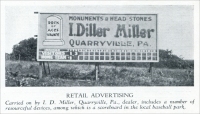
- Bellefonte, Pennsylvania – the Governor Curtin Monument (from The
Commercial Granites of New England, Bulletin 738, 1923.)
Commercial use of material within this site is strictly prohibited. It is not to be captured, reworked, and placed inside another web site ©. All rights reserved. Peggy B. and George (Pat) Perazzo (deceased).

